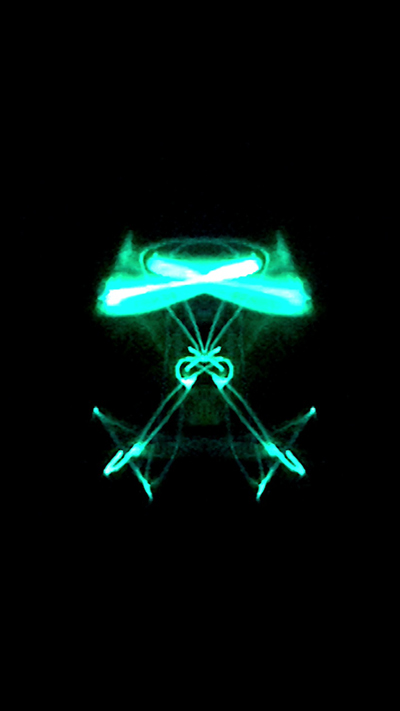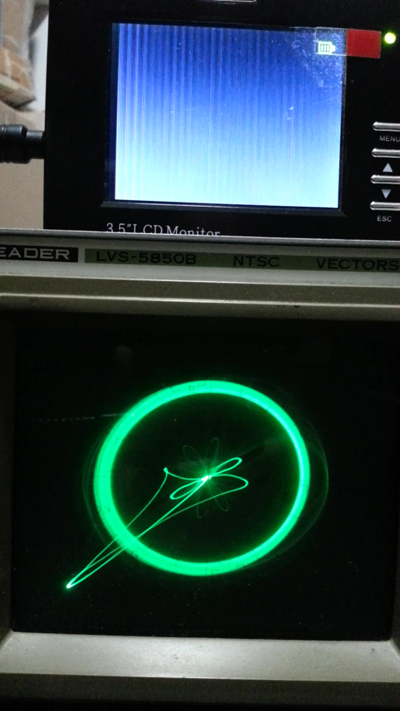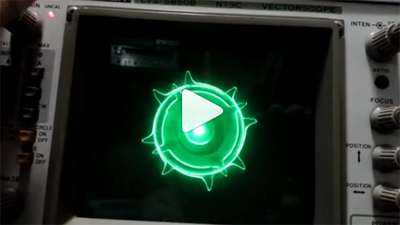Making of: the Amin Bhatia-Ari Posner IGTV Podcast Teaser
Earlier this week I posted a podcast interview with Amin Bhatia and Ari Posner, the composers of the CBC-Netflix series Anne with an E which ended its run after 3 seasons.
I plotted a teaser for my IGTV channel that made use of old test equipment, but instead of feeding audio into an oscilloscope, I wanted to bounce between picture shaping sound, and sound shaping picture, in one ‘fluid’ workflow.
Bear in mind the teaser is a test – it took multiple takes before I captured one that didn’t have sync hiccups – but it means further ideas are possible with other chunky gear.
First, take a peek at the IGTV podcast teaser:
Now then. The patching is relatively simple: take the multiburst test pattern from a B&K 1260 NTSC Test Generator and send it into a Showtime Video Ventures Video Colorizer, which drenches the footage into bright primary colours.
Feed audio from the podcast into the colorizer and adjust pots so the pattern starts to pulse; send the video into a Showtime Video Ventures Color Processor; and send that footage into a Leader LVS-5850B vectorscope.
Videotape the pulsing patterns (a Sony CCD-TRV608 Hi8 camera), and after digitizing it as a ProRes MOV file, layer and colour tweak it in Premiere before rendering.
There were a lot of problems during the process, largely because the SVV Colorizer is both extremely twitchy, and most likely in need of a serious recap. I’ve two units: one used, the other literally new old stock, but the latter is now being affected by the problems that’s made the former almost unusable.
The Colorizer needs a clean, stable video signal and audio to both colorize and allow for pulsing effects, and to get that you have to be patient and move the pots slowly until you see a pulse. Then wait for the circuits to catch the audio, and ever so slightly, adjust the pots to get a more detailed image, and greater degree of movements.
It’s not like one of LZX’s excellent video synth modules where the results can be immediate; the Colorizer takes time to react, and if you move any pot too quickly in either direction, the sweet spot vanishes, and you’ve just got a full frame of red, blue or yellow.
The used Colorizer now has major sync issues – whatever signal it’s fed, it can’t lock onto neither vertical nor horizontal sync, so you get gibberish. The second Colorizer now takes longer to warm up, and every so often the vertical sync weakens, causing the image to offset and sometimes degrade into gibberish.
That instability may have caused the B&K test pattern generator to lose sync, resulting in a signal that drops out and pops back ever 10-20 seconds. A partial solution was to send clean Black Burst from a Tektronix SPG-300 into the the Genlock In of the B&K, but more often than not, I had to turn off the B&K for a moment before hitting power and film off the vectorscope FAST before the problem reappeared.
The vectorscope displays a variety of alignment patterns, but when the B&K loses the signal from the Colorizer, it takes a moment before it locks onto the signal again, and the pattern reappears.
More time is required to find out if 1) the B&K is the problem; 2) the Colorizer requires about a half hour to warm up to work relatively stable for a while; 3) does the Tektronix SPG actually make a difference. A lot of time was spent turning the Colorizer and B&W on / off until a clean take was possible.
What was ultimately captured off the vectorscope is footage of a red-tinted multiburst signal which pulses to the audio from the podcast. That audio’s bass was trimmed, and the harsh highs boosted so the pattern pulses. It might have been Take 7 or 8 that ran through clean, and it might have stayed clean for a while as long as the Colorizer remained stable, so there’s more to test.
Within Premiere, grain and details from the vectorscope’s graticule were minimized by adjusting contrast & brightnesss; colour was shifted towards blue-green; and the image was flipped and layered like a Rorschach pattern, and centered.
So… Why go through this trouble?
Because if you can get the colorizer to make whatever test pattern’s being sent from the B&K to pulse, you’ve a wide variety of surreal, squiggly patterns that can be further altered by changing the fibrous lines using the separate SVV Colour Processor’s luminance, colour burst, phase, and colour saturation pots – making the pattern bigger, smaller, and more surreal.
The vectorscope also has a Test Circle option which you can use to create mandala-like patterns from which rings spin and extend inward / outward.
Below are a series of snapshots from the vectorscope, showing the specific test patterns and how they’re read by the vectorscope:
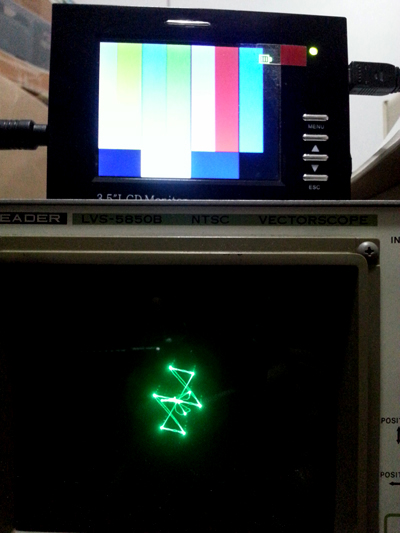
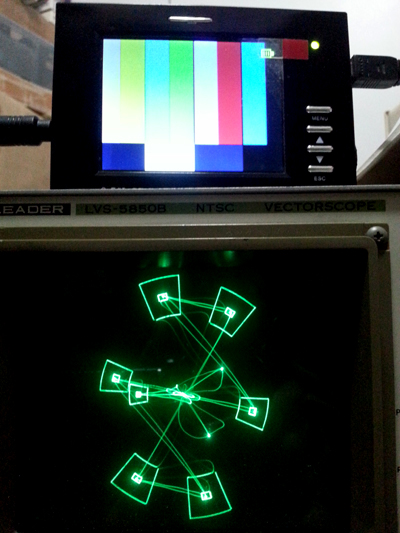
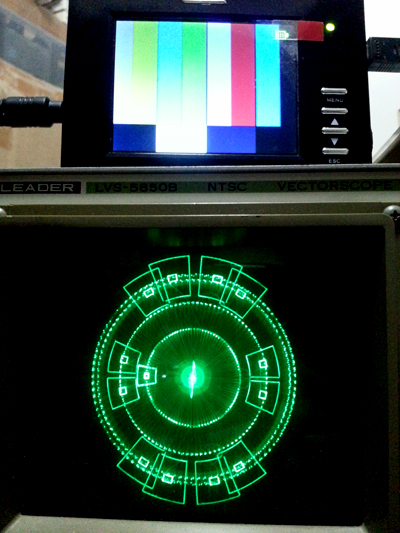
Instagram clip showing how the B&K’s adjustable blue gun multiburst pattern morphs through squiggly lines; a bloom from a crosshair pattern & zooming into the bloom from dots; and zooming into rotating colour bars:
Lastly, here’s a demonstration of the routing for the podcast teaser which shows the B&K 1210, the Showtime Video Ventures Video Colorizer that’s also receiving podcast audio, the SVV Color Processor used to expand the pattern, the Tektronix SPG-300 which is sending a stable blackbust signal to the B&K’s genlock input, and the Leader LVS-5850B vectorscope from which the bendee-foldee-twistee footage originated:
And as for the most important questions on your mind, Yes, the ‘scope has a Z-axis, and Yes, the permanent graticule is on the glass monitor, BUT it’s very faint, and with the side intensity bulbs turned off, you can pretty must dial out the graticule in Premiere.
You can find separate graticule generators on Ebay, and the reason why you (well,certainly I) might want one is that by playing with colour and corrupting sync, what transpires on the ‘scope can look especially striking – vibrating & contorted shapes which, like finding a special blend of synth tones + delay, filtering, etc., are gold.
Thanks for reading,
Mark R. Hasan, Editor
Big Head Amusement

